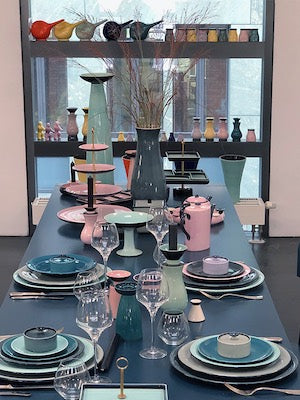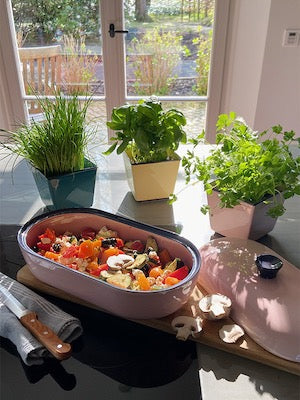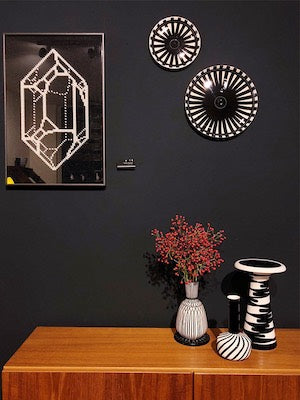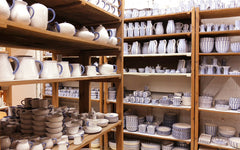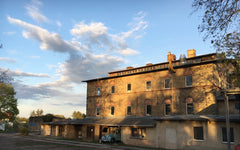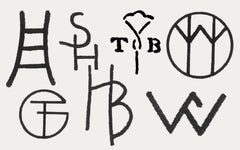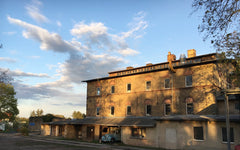Bauhaus Design
The Deutscher Werkbund, founded in 1907, and the Bauhaus, founded in 1919, have had a lasting influence not only on form and design, but also on our taste. The Werkbund had set itself the goal of making tasty mass-produced products accessible to every group of buyers in an industrial society essentially geared towards profit. The Bauhaus, initially significantly influenced by the Werkbund, became the most important school for architecture, design and art in the 20th century. This radiance extends to the present day.

Our handmade and hand-painted ceramics in Bauhaus design brings tradition to timeless perfection. It impresses with its functional design language, high functionality and stylish charisma. In the Bauhaus Edition by Hedwig Bollhagen, the basic idea of the Werkbund and Bauhaus lives on to this day. The best way to get to know our ceramics manufactory is live - during a factory tour in Marwitz you can experience up close how Bauhaus classics are lovingly made by hand.

Werner Burri Bauhaus Collection

Hedwig Bollhagen Bauhaus Collection
Harkort works in Velten Vorda
In addition to Hermann Harkort, the director of the Steingutfabriken Velten-Vordamm - a committed advocate of the Werkbund and Bauhaus ideas and a mentor to young Bauhaus students - two other employees from the Bauhaus ceramics workshop had a major influence on Hedwig Bollhagen: Theodor Bogler and Werner Burri. Both Bauhaus ceramists left their mark in the HB workshops in Marwitz, the “little Bauhaus” in Brandenburg. Until the end of 2021, his storage jars and Werner Burri's butter dish were made here in Bogler's original form using the casting process.
Hedwig Bollhagen about himself:
"I was very fortunate to be able to work in the Velten-Vordamm earthenware factory in 1927 right after I finished my technical school. To be able to join Harkort and start an activity that was... decisive for my whole work.” Gratitude and enthusiasm of a reflective Hedwig Bollhagen. The director of the earthenware factories, Dr. Hermann Harkort was a member of the Deutscher Werkbund with his Velten factory. His credo: He wanted to win over artists, who were generally averse to the industry, to design the mass production of hand-painted earthenware crockery. And show that it is also possible to convey beauty and joy in everyday use.
The artistic demands of the population should be increased: This would only be possible with a kitsch-free, factual form that has to fulfill a function. Every product should unequivocally express what it was made for. Function at a high level of quality and design. The "education" of the consumer in good taste was to be guaranteed by a school for designers that taught according to the same principles. The Bauhaus, founded in 1919 and initially significantly influenced by the Werkbund, became the most important school for architecture, design and art of the 20th century in its 14-year history. The directors Walter Gropius, Hannes Meyer and Ludwig Mies van der Rohe aspired to rethink design from the ground up. A conviction that enabled the artistic awakening of craftsmanship into the modern age. This is how the professional profile of the artistic craftsman, the designer, which we call designers today, came into being.
A letter and its consequences
On March 23, 1923, Bauhaus teacher Gerhard Marcks made the following suggestion to Bauhaus director Walter Gropius: "For Bogler, a trip to Velten would be desirable ... The relationship with Velten would be very welcome in your sense of the industrialized Bauhaus."
What a brilliant move.
Theodor Bogler, the avant-gardist among the ceramists at the Bauhaus, shaped the prevailing ideas about ceramics at the Bauhaus. To this day, some of his works are exemplary for Bauhaus ceramics. In Velten, Bogler received his first insights into industrial ceramic manufacturing techniques, including the casting process. A creative quantum leap. By using the casting process, he revolutionized the forms of ceramics in the Dornburg Bauhaus workshop, which until then had only been used for turning. The free turning was now a production process for the series production of jugs (handle and spout were garnished afterwards and pressed or cast separately). The tool costs (model equipment and mold construction) do not allow every ceramics manufacturer to use this process to this day. His legacy: He created objects for eternity. Its three storage jars in different sizes, the wall container for flour and the slim lidded bottles for vinegar and oil are legendary. Kitchen has never been more beautiful.
Bogler consistently developed the design principle of his kitchen set in what is probably his most famous design series, his combination teapot. It remains to be mentioned that the ingenious ceramist - according to his own statement - received the suggestion for this from Walter Gropius. However, the desired industry adoption of the combination teapot, for which it was ultimately designed, never materialized. It remained with the production of small series in the Dornburg workshop. At the same time, Bogler designed stoneware and porcelain models for his legendary mocha machine. Although the word machine seems a bit exaggerated these days: It was simply a mobile vessel combination for heating water and pouring mocha at the table. In 1924 Bogler left the Bauhaus and took over management of the model and mold workshop in Velten-Vordamm. Bogler only stayed two years; In early 1927 he entered the Benedictine Abbey of Maria Laach. He also designed various ceramics, using forms by Hedwig Bollhagen for his decorations. After the stoneware factory went bankrupt in 1931, Bogler worked for a time between 1934 and 1938 with the HB workshops Hedwig Bollhagen in Marwitz.
More important for Hedwig Bollhagen, however, was the collaboration and friendship with Werner Burri, who came to Velten shortly after her as a freelance artist and worked closely with her until 1931. While he was still overshadowed by Bogler at the Bauhaus, he was able to develop freely in Velten. He now had his own "Burri Collection" consisting of vases and jugs, some of which are still in the range today. Bollhagen and Burri have apparently inspired each other in their work.
In Velten, Hedwig Bollhagen, who had already dealt intensively with the ideas of the Werkbund and Bauhaus during her training, came closer to her goal of designing well-designed, functional and functional ceramics that Vel could afford. "I was very interested in making utility tableware that could sell cheaply and thereby give the buyer a way of moving away from the really very tasteless, mendacious tableware that the china and earthenware industry was bringing to the market," she said. Unambiguity and clarity and consistency not only in ceramics, but also in words. The great ceramist Hedwig Bollhagen, who never studied at the Bauhaus herself, carried on the idea of the most important school for architecture, design and art with the deepest conviction and dedication. The basic idea of the Werkbund and Bauhaus - in Marwitz, about 300 kilometers from the cradle of the Bauhaus, you can still feel it.
